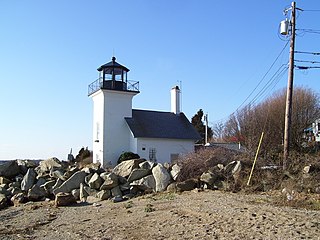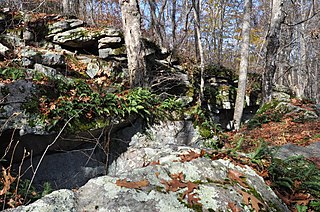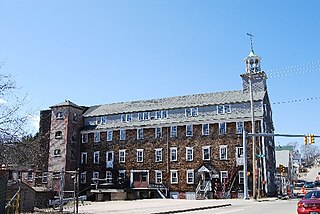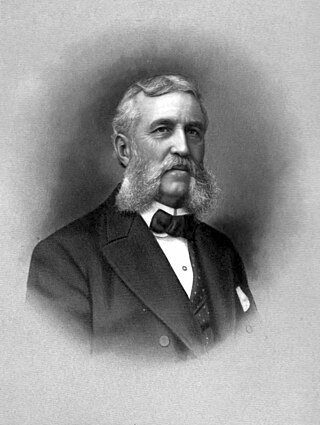
Barrington is a suburban, residential town in Bristol County, Rhode Island, United States, located approximately 7 miles (11 km) southeast of Providence. It was founded by Congregationalist separatists from Swansea, Massachusetts and incorporated in 1717.
Watch Hill is an affluent coastal neighborhood and census-designated place in the town of Westerly, Rhode Island. The population was 154 at the 2010 census. It sits at the most-southwestern point in Rhode Island. It came to prominence in the late 19th and early 20th century as an exclusive summer resort, with wealthy families building sprawling Victorian-style "cottages" along the peninsula. Watch Hill is characterized by The New York Times as a community "with a strong sense of privacy and of discreetly used wealth," in contrast with "the overpowering castles of the very rich" in nearby Newport.

Swan Point Cemetery is a historic rural cemetery located in Providence, Rhode Island, United States. Established in 1846 on a 60-acre (0.24 km2) plot of land, it has approximately 40,000 interments.

Union Village or "Bank Village" is a village and historic district located in North Smithfield and Woonsocket, Rhode Island on Rhode Island Route 146A. Union Village developed because it was at the cross roads of old Great Road and Pound Hill Road.

Lime Rock (Limerock) is a village and historic district in Lincoln, Providence County, Rhode Island, United States, near Rhode Island Route 146. The village was named after the limestone quarries in the area, which started in the 17th century, and continue to the present where Conklin Limestone Company now operates. Because of the abundance of limestone in the area many houses had massive end chimneys and were called "stone enders," a distinctly Rhode Island style of architecture. The historic district includes 21 historically significant properties in an area extending from Wilbur Road, just west of its junction with Old Louisquisset Pike, eastward to Great Road, and then along Great Road as far as Simon Sayles Road. Among these properties are three quarries, and the ruins of three old lime kilns. It was listed on the National Register of Historic Places in 1974.

Bristol Ferry Light is a historic lighthouse in Bristol, Rhode Island, United States. It is located on the shores of Narragansett Bay at Bristol Point, the northern land point of Mount Hope Bay at the base of the Mount Hope Bridge.

Nayatt Point Light is a historic lighthouse in Barrington, Rhode Island.

The Benjamin Barker House was a historic house on Main Road in Tiverton, Rhode Island. Built c. 1850, it was a two-story wood-frame structure with an impressive Greek Temple front, with full-height fluted Ionic columns supporting a full triangular pediment. The pediment had an astylistic triple window in it. The roof was topped by an octagonal cupola with belvedere, with two narrow chimneys piercing the ridge line. It is possible the house was designed by Russell Warren, who is documented to have designed a number of other high-style Greek Revival houses in the region. The purchaser is believed to be Benjamin Barker, a lumber merchant operating in nearby Fall River, Massachusetts.

The Windmill Hill Historic District is a historic district encompassing a large rural landscape in Jamestown, Rhode Island. It is bounded on the north by Eldred Avenue, on the east by East Shore Road, on the south by Great Creek, and on the west by Narragansett Bay. The area's historical resources included six farmsteads, as well as the Quaker Meetinghouse, the Jamestown Windmill, and its associated miller's house and barn. The area is predominantly rolling hills with open pastureland and forest. The district was listed on the National Register of Historic Places in 1978. The area is also rich in prehistoric evidence of Native American occupation, which is the subject of the Jamestown Archeological District listing on the National Register.

The Benjamin F. Greene House is an historic house at 85 Cross Street in Central Falls, Rhode Island, USA. The Second Empire house was designed by Clifton A. Hall and built by Wheeler & Marchant in 1868. The house is one of a small number of high-style mid-19th century houses in the city. It was built for Benjamin Franklin Greene, a second-generation mill owner in the Central Falls/Pawtucket area.

The Squantum Association is a private club in East Providence, Rhode Island on 947 Veterans Memorial Parkway. Its main Club House overlooks the Providence River on a rocky promontory. This Colonial Revival building was constructed in 1900 by Martin & Hall and added to the National Register of Historic Places in 1980. The brick bakehouse was built in 1899 and has weathered numerous hurricanes from its lofty perch right on the rocky coast. The "Cottage" is the oldest building on the property and was originally built as a billiard hall. Also surviving from the 19th century is the club office, formerly the manager's residence.

The Ezekial Gardner House was an historic house at 297 Pendar Road in North Kingstown, Rhode Island. It was a 1+1⁄2-story wood-frame house, with a gambrel roof. The oldest portion of the house dated to the early 18th century, and was the best-preserved of several period houses built by members of the locally prominent Gardner family. The house stood, along with an early 20th-century barn, at the end of a long tree-lined lane on the west side of Pendar Road.

The Palmer–Northrup House is an historic house at 7919 Post Road in North Kingstown, Rhode Island. It is a 2+1⁄2-story wood-frame structure, and is one of a small number of surviving stone ender houses in the state. Its architecture suggests it was built in the 17th century, either around the time of King Philip's War (1675–78) or possibly even earlier. The oldest portion of the house, including its massive fieldstone chimney, are relatively intact despite later additions around 1740 that significantly enlarged the house. The house stands across the street from Smith's Castle, a house of similar vintage which was built on the site of a trading post established by Roger Williams in 1637.

The Tomaquag Rock Shelters (RI-HP-1) are a prehistoric rock shelter site off Maxson Hill Road in Hopkinton, Rhode Island. The shelters are located under two east-facing granite outcrops in the valley drained by Tomaquag Brook. Nathan Kaye discovered the shelters in the late 1950s. Materials recovered from test excavations resulted in dating one shelter to 800 BC and the other to AD 800. Materials recovered include projectile points, stone knives, and evidence of stone tool construction. Both sites included evidence pointing to the presence of a fire pit.

The Lippitt Mill is an historic mill at 825 Main Street in West Warwick, Rhode Island.

The House at 18A and 20 Aborn Street in Wakefield, Massachusetts is a historic house and carriage house with elaborate Queen Anne styling. It was built in the mid-1880s, and is one of the most ornate houses in the neighborhood. The property was listed on the National Register of Historic Places in 1989.

The House at 9 White Avenue in Wakefield, Massachusetts is a well-preserved transitional Queen Anne/Colonial Revival house. Built about 1903, it was listed on the National Register of Historic Places in 1989.

Norman Bird Sanctuary is a 325-acre (1.32 km2) bird sanctuary, nature preserve, environmental education center, and museum at 583 Third Beach Road in Middletown, Rhode Island overlooking the Atlantic Ocean.

John Holden Greene (1777-1850) was a noted early nineteenth century architect practicing in Providence, Rhode Island. The bulk of his work dates to the late Federal period, and is mostly in the architectural style of the same name. Greene is responsible for the design of over fifty buildings built in the city between 1806 and 1830, almost half of which are still standing.

Edward I. Nickerson (1845–1908) was an American architect from Providence, Rhode Island, known for his work in the Queen Anne style in Providence.





















